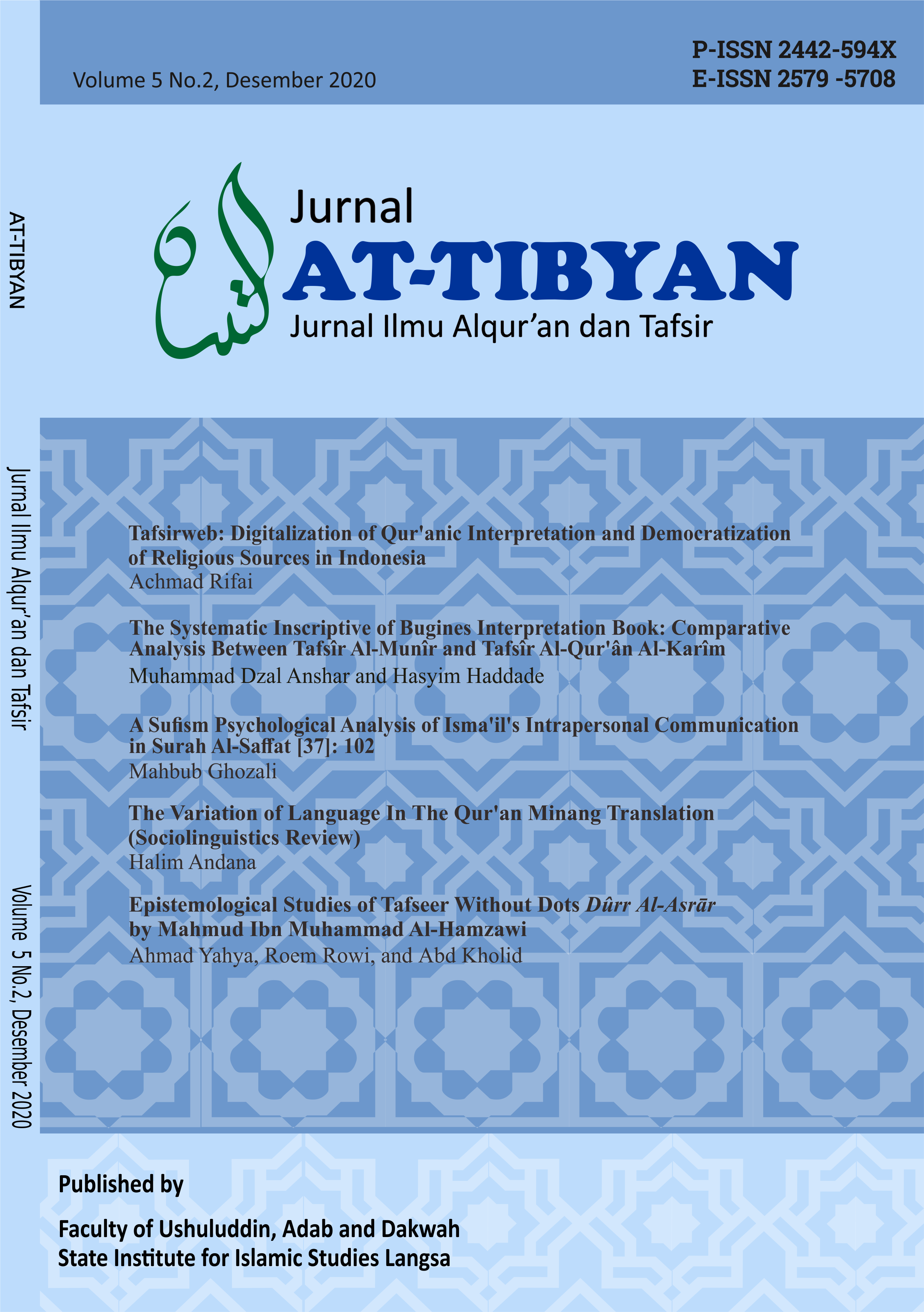Main Article Content
Abstract
This paper aims to explore the Characteristics of the Tafsir Method used by Abu 'Abdu ar-Rahman Muhammad al-Sulamy in his book HaqÄiqu Tafsîr. In addition, this paper also reveals the Sufistic values ​​contained in the story of the Prophet Musa and 'Abd which are allegedly the Sufistic Story in the Quran. In conducting the research, the writer used qualitative descriptive research analytical. So that the data obtained are not only described but also analyzed. From the results of this study it is concluded that the characteristics of the al-Sulamy Tafsir Method can be concluded as follows. First, in interpreting the Quran, al-Sulamy arranged the surahs according to the order of the Usmani Manuscripts, namely from Surat al-Fatihah to Surat an-Nas by not interpreting the entire verse in the letter. Second, in several interpreted verses, al-Sulamy's interpretation style refers to the bi riwayah or naqly interpretation by quoting the ayat (verse) or hadith. Third, in quoting certain opinions, sometimes al-Sulamy did not use the bright name of the Sufi, he used the identity of a Sufi group in a certain area, for example, 'Iraqiyyin (Sufis from Iraq), Bagdadiyyin (the Sufis from Baghdad). Fourth, the methods used by al-Sulamy in interpreting verses in the Qur'an are predominantly the isyari method. Fifth. in interpreting, al-Sulamy also contributed in conveying his ideas regarding the meaning of certain verses. The Sufistic values ​​that can be concluded from the story of the Prophet Musa and 'Abd are lessons about the nature of worship which is not only oriented towards external or physical movements of worship, synergies between fiqh and Sufism in order to get closer to Allah, the prohibition of greedy and riya' , the urgency of knowing one's position in worshiping Allah SWT, the importance of having good character in knowledge, and calming the soul.
Keywords
Article Details

This work is licensed under a Creative Commons Attribution 4.0 International License.
References
- Abd Rahman, Khalid. Ushulu At-Tafsir Wa Qawaiduhu. Beirut: Dar an-Nafais, 1986.
- Adz-Dzahabi, Muhammad Husein. At-Tafsir Wa Al-Mufassirun. Qahirah: Maktabah Wahbah, Tanpa Tahun.
- Ajibah, Ahmad bin Muhammad. Al-Futuhat al-Ilahiyyah Fi Syarhi Mabahisi al-Asliyyah. Beirut: Dar Al Kotob Al Ilmiyah دار الكتب العلمية, Tanpa Tahun.
- Al-Fanjari, Ahmad Syauqi. Nilai-Nilai Kesehatan Dalam Syariat Islam. Jakarta: Bumi Aksara, 1996.
- Al-Qattan, Manna Khalil. Studi Ilmu-Ilmu Qur’an = Mabahis Fi ’Ulumil Qur’an. Jakarta: Pustaka Litera AntarNusa, 2004.
- Bruinessen, Martin van, and Julia Day Howell. Sufism and the “Modern†in Islam. I.B.Tauris, 2007.
- Elias, Jamal J., and ïº‡ï»Ÿï»´ïºŽïº±ïºŸï»¤ïºŽï» ïº. “ṢūfÄ« TafsÄ«r Reconsidered: Exploring the Development of a Genre / ‫ﺇﻋﺎﺩﺓ‬ ‫ﻧﻈﺮ‬ ‫ﻓﻲ‬ ‫ïºï»Ÿïº˜ï»”ﺴﻴﺮ‬ ‫ïºï»Ÿïº¼ï»®ï»“ﻲ‬ ‫ï»ïº—ﻄﻮïºï»©â€¬ ‫ﻛﻔﻦ‬ ‫ﺧﺎﺹ‬.†Journal of Qur’anic Studies 1 (2010): 41–55. http://www.jstor.org/stable/25831164.
- Ghazi, Muhammad. An-Nusu Fi Mustalahati at-Tasawwuf. Damaskus: Dar Qutaybah, 2000.
- Giddens, Anthony. Konsekuensi-Konsekuensi Modernitas. Yogyakarta: Kreasi Wacana, 2017.
- Godlas, Alan. “Influences of Qushayrī’s Laá¹Äʾif al-IshÄrÄt on Sufi Qur’anic Commentaries, Particularly RÅ«zbihÄn al-Baqlī’s Ê¿ArÄʾis al-BayÄn and the Kubrawi al-TaʾwÄ«lÄt al-Najmiyya.†Journal of Sufi Studies 2, no. 1 (2013): 78–92. https://doi.org/10.1163/22105956-12341248.
- Hendricks, Mogamat Mahgadien. “The Qur’Änic Sufi Hermeneutics of Shaykh Muá¹£á¹afÄ’ al-‘AlÄwÄ«:,†n.d., 292.
- Hs, MA Achlami. “Sufi Exegesis of the Qur’an and Its Public Controversy.†Advances in Social Science, Education and Humanities Research 492 (n.d.): 6.
- Ibda, Hamidulloh. “Penguatan nilai-nilai sufisme dalam nyadran sebagai khazanah islam nusantara.†Jurnal islam nusantara 2, no. 2 (November 20, 2018): 148. https://doi.org/10.33852/jurnalin.v2i2.92.
- Kaelan, Kaelan. Metode Penelitian Agama Kualitatif Interdisipliner. Yogyakarta: Paradigma, 2010.
- Kuru, Zeynep Akbulut, and Ahmet T Kuru. “Apolitical Interpretation of Islam: Said Nursi’s Faith-Based Activism in Comparison with Political Islamism and Sufism.†Islam and Christian-Muslim Relations 9, no. 1 (January 2008): 15.
- Mahsun, M. S. Metode penelitian bahasa: tahapan strategi, metode dan tekniknya. Jakarta: PT RajaGrafindo Persada, 2005.
- Maryam, Musharraf. “A Study on the Sufi Interpretation of Qur’Än and The Theory of Hermeneutic.†Al-Bayan Journal 11, no. 1 (2013): 33–47. https://doi.org/ 10.11136/jqh.1311.01.03.
- Mushodiq, Muhamad Agus. “Perilaku Patologis Pada Kisah Nabi Musa Dan ‘Abd Dalam Alquran: Telaah Epistemologi al-Jâbirî dan Semiotika Peirce.†ULUL ALBAB Jurnal Studi Islam 19, no. 1 (June 25, 2018): 69–97. https://doi.org/10.18860/ua.v19i1.4816.
- Muttaqin, Muhamad Zaenal. “Geneologi tafsir sufistik dalam khazanah penafsiran al-qur’an.†Jurnal Tamaddun : Jurnal Sejarah dan Kebudayaan Islam 7, no. 1 (June 28, 2019). https://doi.org/10.24235/tamaddun.v7i1.4504.
- Nurhayati, Ifa. “Dimensi Sosiologis Sufisme dalam Lintasan Sejarah: dari Asketisme Sufisme-Klasik hingga Post-Modernisme.†Islamica: Jurnal Studi Keislaman 3, no. 1 (January 22, 2014): 96. https://doi.org/10.15642/ islamica. 2008.3.1.96-106.
- Putra, D.I Ansusa. “Epistemologi Tafsir Sufi Perspektif Esoterik-Fenomenologi.†Ulul Albab Jurnal Studi Islam 19, no. 2 (December 28, 2018): 185–208. https://doi.org/10.18860/ua.v19i2.5019.
- Sulamy, Abu ‘Abdu ar-Rahman Muhammad ibn Husain ibn Musa al-Azdy al-. Haqaiqu At-Tafsir; Tafsiru al-Qur’an al-Aziz. Beirut: Dar Al Kotob Al Ilmiyah دار الكتب العلمية, 2001.
- Suryadilaga, M. Alfatih. Metodologi Ilmu Tafsir. Yogyakarta: Teras, 2005.
- Syarifuddin, Mohammad Anwar. “Measuring the Haqa’iq al-Tafsir: From Its Contentious Nature to the Formation of Sunnite Sufism.â€Journal of qur’an and hadith studies 2, no. 2 (December 20, 2013): 209–45. https://doi.org/ 10.1548/quhas.v2i2.1315.
- Tafsir al-Quran dalam sejarah perkembangannya, 2019.
- Wahyudi, Wahyudi. “Epistemologi tafsir sufi al-ghazali dan pergeserannya.†Jurnal Theologia 29, no. 1 (September 2, 2018): 85. https://doi.org/10.21580/ teo.2018.29.1.2070.
- ———. “Tafsir Sufi: Analisis Epistemologi Ta’wîl Al-Ghazâli Dalam Kitab Jawâhir Al-Qur’ân.†Jurnal Ushuluddin 26, no. 1 (June 4, 2018): 44. https://doi.org/10.24014/jush.v26i1.4243.
- Wahyudi, Wahyudi, and Ahmad Zaini. “Characteristics And Paradigm of Tafsir Sufi Tafsir In Abid Al-Jabiri Epistemology Perspective.†Kalam 12, no. 1 (June 2018).

